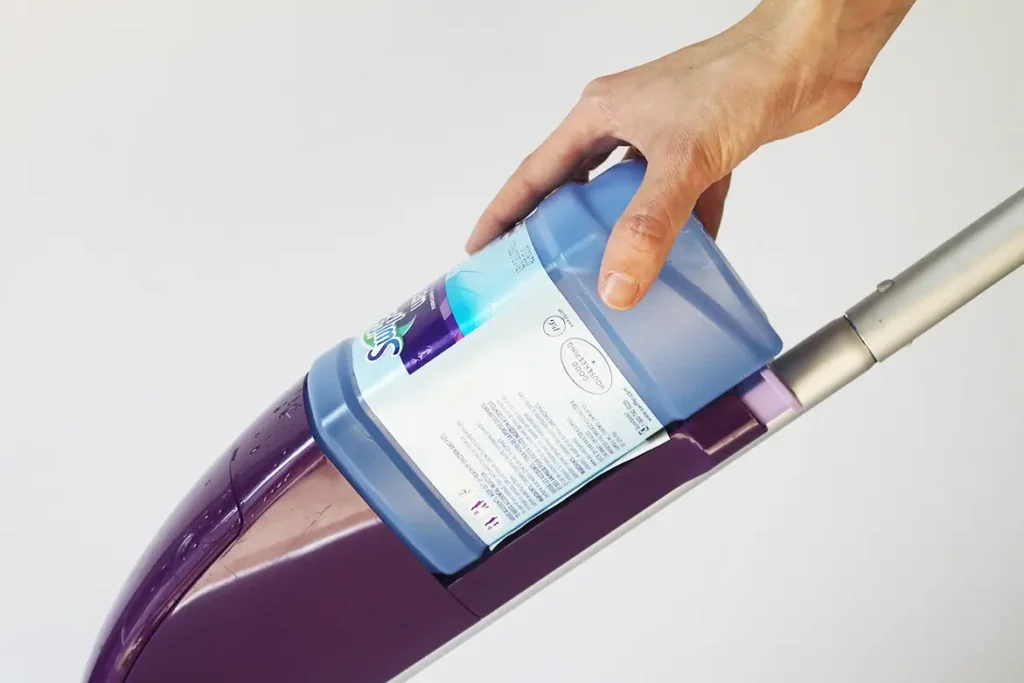A Swiffer can be your go-to companion for quick cleanups and everyday floor maintenance. But when something goes wrong—like a sudden leak or a spray that won’t activate—it can throw off your whole routine. At DecorifyIt, we believe cleaning should stay simple and stress-free. That’s why we’ve put together this friendly, expert-backed guide to solve the most common Swiffer issues before you throw in the mop.
1. Swiffer WetJet Not Spraying? Try These Fixes First
When your WetJet stops spraying, it’s often an easy fix—no screwdriver required.
✅ Double-Check the Cleaning Solution Bottle
Make sure your solution bottle is clicked into place with the label facing up. A solid click sound tells you it’s properly locked in. If the bottle isn’t seated correctly, the pump system can’t draw fluid.
🔋 Inspect and Refresh the Batteries
The WetJet uses 4 AA batteries, and if even one is misaligned or corroded, the sprayer may not work. Pull the batteries out and check for rust or white buildup on the terminals. Wipe the contact points with a dry cloth—or gently rub with a pencil eraser if there’s corrosion—and try again with fresh batteries.
A quick tip from Swiffer’s support team: Always use alkaline batteries, not rechargeable ones, as they offer a more consistent voltage flow.
🚿 Unclog the Spray Nozzles
Grimy buildup at the spray nozzles (located at the front end of the mop) can block the stream. Straighten a paperclip and gently insert it into each nozzle to loosen any gunk or dried cleaner. Run a test spray again.
🔄 Hold Down the Spray Button
If your Swiffer hasn’t been used for a while, the pump may need a few seconds to build pressure. Hold the button down continuously for 5–10 seconds to prime the system.
🛠️ Still No Spray?
If none of the above steps work, it may be a mechanical defect or a deep clog inside the tube. Contacting Swiffer support or checking your warranty might be the next best step.
2. Dealing with a Leaking Swiffer WetJet
A leaking mop is not just messy—it wastes cleaning solution and can leave streaks behind.
🔍 Inspect the Rubber Seal
Take the solution bottle out and look at the clear rubber seal around the neck. Dirt buildup or a small tear can break the vacuum seal, causing leaks. A quick rinse and wipe may solve it, but if the seal looks worn, replace the bottle.
According to Procter & Gamble, Swiffer’s parent company, WetJet bottles are designed for single-use only. Refilling them might weaken the seal or deform the plastic, leading to leaks over time.
👌 Make Sure the Bottle Is Installed Properly
The narrow end of the bottle should point toward the pole, and it should fit snugly with a click. If the bottle wobbles or sits at an angle, remove and reinstall it until it’s fully secured.
🧴 Avoid DIY Refills
We get the appeal—saving money and reducing waste—but refilling the bottle with homemade solutions can cause air leaks and disrupt the spray pressure. If you want a more eco-friendly option, consider buying compatible reusable bottles designed for WetJet systems (but remember, they void the warranty).
3. Swiffer Pads Not Picking Up Dirt? Here’s What to Check
When your Sweeper pad just pushes debris around instead of trapping it, don’t toss the whole device—start with these smart checks.
🧼 Is the Pad Saturated?
A Swiffer pad loses its grip when it’s already full of dust. If it feels heavy or gray, it’s time for a fresh one. Also, make sure the pad is attached tightly along the grippers. A loose fit can reduce surface contact.
👎 Using Generic Pads?
Not all cleaning pads are created equal. Swiffer’s pads use electrostatic fibers and texture ridges that are engineered to trap fine dust. Off-brand pads may look similar but often lack the static cling needed to pick up smaller debris efficiently.
Consumer Reports testing found that Swiffer-branded dry pads picked up 25–30% more dust and pet hair than generic versions on hard floors.
📏 Adjust Your Cleaning Strategy
For larger messes—like cereal spills or pet fur clusters—vacuum first or use a Swiffer Sweep + Vac to avoid clogging your pad. Save your dry Sweeper for the finishing touch. That way, it works longer and more effectively.
4. Swiffer SweeperVac Not Turning On? Here’s What to Do
If your SweeperVac is silent or weak, don’t panic. It’s usually a battery or blockage issue.
🔋 Check the Battery Status
Charge the device fully and test the runtime. If it dies quickly or doesn’t power on, the battery may need to be replaced—especially if it’s older than a couple of years.
According to Swiffer’s maintenance guide, SweeperVac’s internal battery usually lasts about 2–3 years, depending on usage.
⚡ Test the Power Button
Press and hold the button for a second or two to be sure it’s not stuck. Sometimes grime can collect around the edges, preventing it from registering a press. A quick wipe-down with a microfiber cloth may fix the issue.
🧹 Empty the Dirt Bin and Clean the Filter
If your SweeperVac is humming but not picking up debris, check the dirt bin. If it’s full, airflow gets blocked. While you’re at it, rinse or replace the filter if it’s visibly dusty or discolored. A clean filter helps maintain suction power.
🔎 Check for Hose Blockage
Disconnect the parts (as shown in your manual) and inspect the suction hose or nozzle for pet hair, cereal bits, or lint. A gentle tap or a soft-bristle brush can help dislodge stuck particles.
When All Else Fails: Contact Support or Replace
If none of these solutions bring your Swiffer back to life—especially for models under a year old—don’t forget your warranty. Swiffer usually offers a 1-year limited warranty on its devices.
You can reach Swiffer’s support at their official help center:
👉 https://www.swiffer.com/en-us/contact-us
Keep your receipt and product serial number handy for faster service. They may offer a replacement or coupon if your device is still under coverage.

